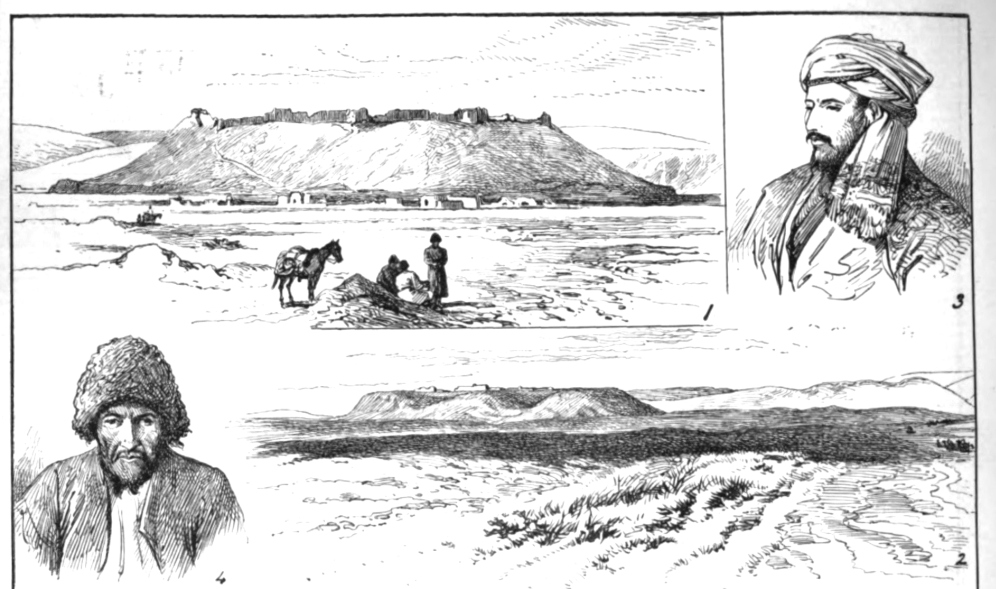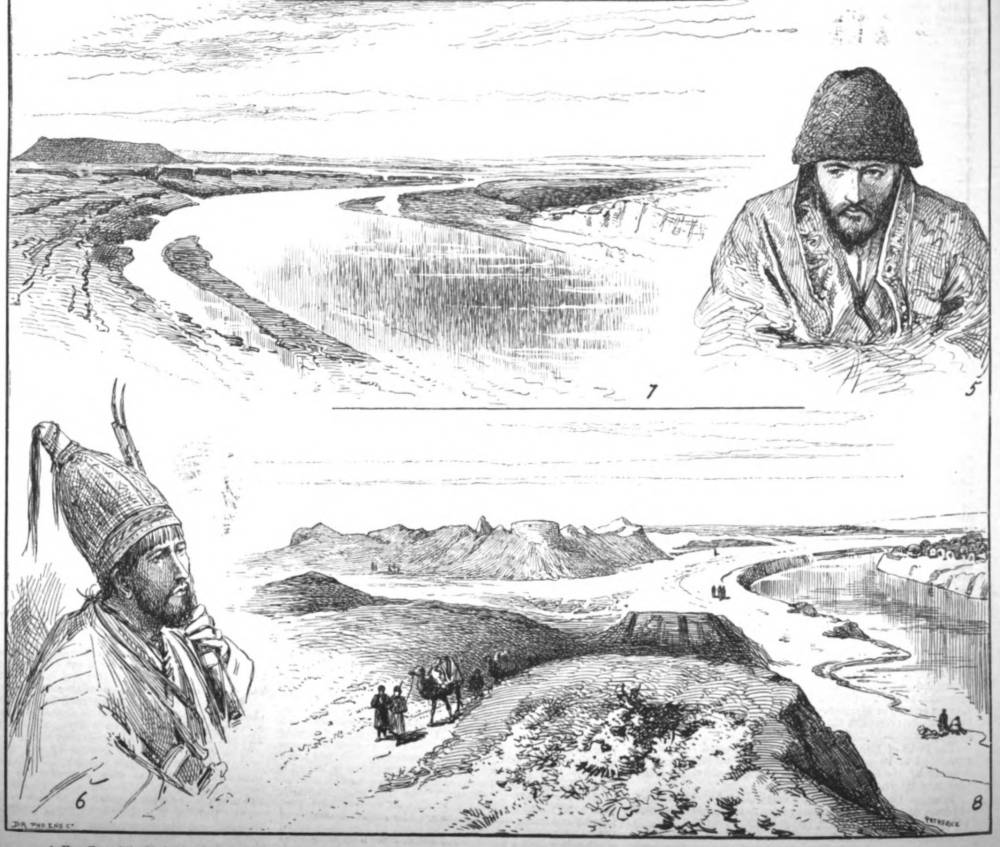
Durbar at Kuhsan. W. Simson. The names under the drawing read from let to right: Mr. A. Coudie Stephen, Governor Herat, Sir P. Lumsden, Kzai Saad-ud-din, Colonel Ridgeway. [Click on image to enlarge it.]
Our Special Artist, Mr. W. Simpson, accompanying Major-General Sir Peter Lumsden, the British Commissioner for the survey and delimitation of the north-western boundary of Afghanistan towards Russian Turkestan, contributes the Sketch of a Durbar, or ceremonial reception, held at Kuhsan, the place where Sir Peter Lumsden and his official Staff were joined by the military escort sent from India under command of Colonel Ridgeway. Kuhsan, on the Heri-rud, is distant 767 miles from Quetta by the somewhat circuitous route which Colonel Ridgeway’s troops, consisting of the 11th Bengal Lancers and the 20th Punjaub [sic] Infantry, with numerous camp-followers, were directed to take in order to avoid passing through the more populous districts of Afghanistan. They performed this march in fifty-seven days, reaching Kuhsan on Nov. 17, and were there met, in a day or two, by the British Commissioner and his party, who had travelled eastward through Persia and Khorassan. With Sir Peter Lumsden were Captain Burrow, his aide-de-camp; Mr. A. Condie Stephen, Assistant Commissioner; Nawab Mirza Hassan Ali Khan; Major Holdich, R.E., of the Survey Department; Captain Durand and Captain De Lassoe, attachés, and Mohammed Aslam Khan, native attaché, forming the Commissioner's staff; Mr. Simpson travelled in their, company. The Kazi Saad-ud-din, representative of the Amen Abdulrahman Khan, the ruler of Afghanistan, with a camp of his own and an Afghan escort, had received Sir Peter Lumsden on entering the Afghan territory; the Governor of Herat also came to do honour to the British Commissioner; and this Durbar was part of the offcial ceremonies upon the occasion. The following is Mr. Simpson's account of this afiair: —
Major-General Sir Peter Lumsden araived at Kuhsqn on the morning of Nov. 19. The Indian camp had arrived there from the opposite direction two days before. Kuhsan is three marches from Herat, and the Governor of the province of that name came to Knhsan to meet Sir Peter Lumsden. The Durbar took place in a large tent in the camp. The Governor’s name is the Naib Ulhukmut Mohammed Sarwar Khan; he sat on the right of Sir Peter Lumsden, and the Kazi Saad-ud-din sat on the left. On the right of the Governor of Herat sat Mr. Alexander Candie Stephen, Assistant Commissioner, and in a similar position on the other side sat Colonel Ridgeway, another of the Assistant Commissioners. The Indian escort had come up in its long march from Nushki, under the charge of Colopcl Ridgeway; and a number of officers connected with the expedition were present. Those in the foreground on the right, in picturesque uniforms, are the officers of the 11th Bengal Lancers. I also send a portrait of the Governor of Herat, who has long been a stanch adherent of the present ruler of Cabul. He bears a considerable resemblance to Henry VIII.
The Governor of the Russian Trans-Caspian deminions, General Komaroff, did not participate in the exchange of civilities on the frontier; and there has been no sign whatever, during two months since elapsed, of the approach of General Silently, the Russian Boundary Commissioner, who was to have met Sir Peter Lunisden there for the joint execution of their important task. Our Special Artist visited the small Russian camp, which is situated about half-way between Old Sarakhs and the Heri-rud. It did not contain at that time over five or six hundred men. There were about three hundred or more of an infantry regiment, a squadron of Akhal Takes, a squadron of Merv Turcomans, and some few infantry of a corps with Circassian costumes. They were encamped in kibitkas, and as yet they had made no fortifications. A Cossack dance, which Mr. Simpson witnessed in this camp, is the subject of his Sketch presented in our second Illustration, of which he writes the following account: —

Cossack dance before the Russian General Komaroff, at Old Sarakhs
I have already related my visit to Old Sarakhs. At the moment I arrived, Ali Marslan Khan, the Governor of New Sarakhs, was paying a visit to General Komaroff, and was being entertained with a breakfast, which was followed by music and dancing by the soldiers. What I might call the troops of the line first sang and then added dancing; one of them had a violin, on which he played to them; then the Cossacks, as they are called—but they wear a Circassian costume, so I suppose they should be called Cossacks of the Caucasus — took part, and went through a number of performances. I send a Sketch of what seemed the most striking of the dances. A handsome fellow, with two daggers, danced and twisted about, flourishing the daggers as if he was going to kill either himself or someone else. He pointed the daggers to all points of his body; and these movements suggested the idea of self-murder, but I suppose that was not the true idea of the movements. He was much applauded for what he did. General Komaroff and Ali Mardan Khan, and the other oflicers, sat on chairs, looking on, outside of the kibitka, where they had breakfasted. Behind the dancer are other men of the same corps; one had a tambourine, and the others clapped their hands and sang while the dance went on. One of the officers of this corps stood there smoking a cigarette, and he is introduced into the Sketch. On the left of the picture are the more regular kind of Russian soldiers looking on.”
The news of this week mentions a rumoured addition of two thousand troops, with artillery, to the Russian garrison at Sarakhs. Sir Peter Lumsden has left Bala Murghab; and it is doubtful whether the Joint Commission will not be thrown over.
More of Simson’s sketches

1. Kara Tapa, “the Black Mound” on the Kushk River. 2. (lower right) Kasli-i-Maur, on the Kushk River. 3. (top right) Taj Nazer, Eshan or Syud of Punjaub. 4. (bottom left) Abdullah, a Sarok, at Penjdeh.

[The second half of the series begun above.] 5. (top right) Wali Kahn, of Penjdeh, a Sarok. 6. (lower left) Baba Karir (a Dervish), a Sarok Tukoman from Balkh. 7. (top right) The Murghab River, with Ak Tapa, near the junction, with the Kushk River. 8. (bottom right) Kona Penjdeh, “Old Penjdeh, on the Murghab River”
More sketches
- Ak Tapa, on the Murghab, near its junction with the Kushk River: View from the South (plus a portrait of Ghous-el-din Kahn, Afghan general commanding troops at Ak Tapa
- Junction of the Murghab and the Kushk Rivers
- Valley of the Kushk, from Pul-i-Khidi
- Pul-i-Khidi. the “Bridge of Brick,” on the Kushk River”
You may use this image without prior permission for any scholarly or educational purpose as long as you (1) credit the Hathi Trust Digital Library and The University of Michigan Library and (2) link your document to this URL in a web document or cite the Victorian Web in a print one. — George P. Landow
Bibliography
“The Afghan Boundary Commission.” Illustrated London News. (28 February 1885): 217, 219; (7 March 1885): 250-51. Hathi Trust web version of a copy in The University of Michigan Library. Web. 5 January 2016.
Created 5 January 2016